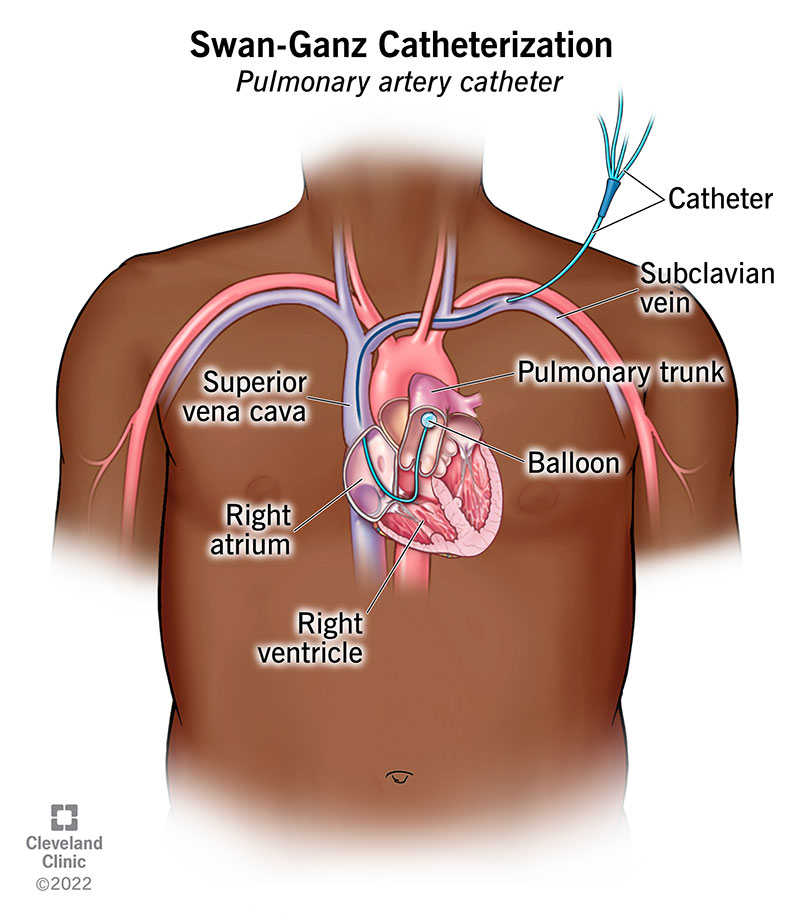A Swan-Ganz catheter helps a healthcare provider get the information they need to diagnose a heart or lung issue and determine treatment. Complications are rare with this test, but it’s invasive. Medication helps you relax while this device is inside your body.
Advertisement
Cleveland Clinic is a non-profit academic medical center. Advertising on our site helps support our mission. We do not endorse non-Cleveland Clinic products or services. Policy

A Swan-Ganz catheter is a medical device a healthcare provider uses to monitor your hemodynamics (how well your blood moves). Also known as a pulmonary artery catheter, it has four lumens (tubes) or ports that feed into one main tube.
Advertisement
Cleveland Clinic is a non-profit academic medical center. Advertising on our site helps support our mission. We do not endorse non-Cleveland Clinic products or services. Policy
Each of the Swan-Ganz catheter ports has a function:
A Swan-Ganz catheter can give your provider information about how well your heart is working. It can tell you:
Yes, healthcare providers still use Swan-Ganz catheters to gather information. Many consider it the “gold standard” for gathering accurate information about what’s going on inside your heart and pulmonary artery.
However, providers don’t use Swan-Ganz catheters as much now for people who are critically ill. Instead, they use echocardiography. This is a noninvasive tool that doesn’t have the risks of a Swan-Ganz catheter.
Advertisement
A healthcare provider may use a Swan-Ganz catheter if they suspect or know you have:
They may also use a Swan-Ganz catheter to collect information before and after a heart transplant, placement of a left ventricular assist device or other surgery.
A provider can use the various Swan-Ganz catheter ports to collect information from inside your body. A Swan-Ganz catheter measures pressure in the chambers on the right side of your heart. The catheter passes through these chambers on the way to your pulmonary artery. After Swan-Ganz catheter placement in your pulmonary artery, a provider can use a balloon at the end of the catheter to measure the pressure inside that artery.
Before a Swan-Ganz catheterization, a healthcare provider will:
A healthcare provider will:
After a healthcare provider removes the Swan-Ganz catheter, they’ll apply pressure to the area where they put in the catheter. They’ll apply a bandage to your skin and ask you to lie still for two to six hours if the catheter was in your leg.
It’s normal to have a bruise where the catheter went into your skin. It goes away in one to three weeks.
Complications from a Swan-Ganz catheter are rare — less than 0.5%. Possible risks from a Swan-Ganz catheter include:
A provider will use the information from your test to guide treatment. Test results can confirm that you have a certain condition. They can also tell your healthcare team about the severity of your issue. Depending on the condition, treatments may include:
Advertisement
Contact your provider if:
A Swan-Ganz catheter can help your provider collect the information they need to diagnose your heart or lung issue. Having this knowledge helps them give you the best treatment for your condition. A provider makes sure you’re comfortable during the test, which rarely has complications.
Advertisement
When your heart needs some help, the cardiology experts at Cleveland Clinic are here for you. We diagnose and treat the full spectrum of cardiovascular diseases.

Last reviewed on 01/16/2023.
Learn more about the Health Library and our editorial process.